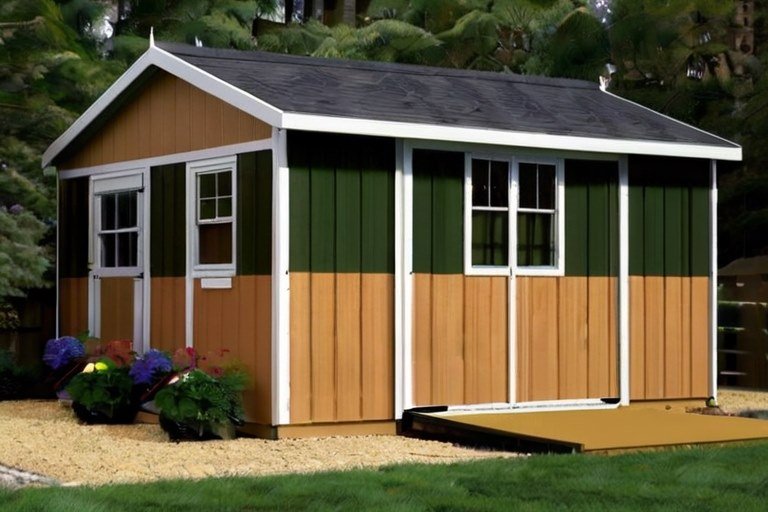Utility sheds are the unsung heroes of outdoor spaces, often serving as storage for tools, equipment, and seasonal items.
Despite their practicality, many utility sheds lack visual appeal, blending into the background rather than enhancing the overall aesthetic of the property.
However, with the right design choices, these humble structures can become eye-catching focal points that add character and charm to any backyard.
One such design choice is board and batten siding, a timeless and versatile option that has been used for centuries in architectural design.
The distinctive pattern of wide vertical boards (the “boards”) paired with narrow strips called battens creates a classic look that exudes rustic elegance.
While the board and batten siding shed is commonly associated with barns and farmhouses.
Its appeal extends far beyond rural settings, making it an excellent choice for utility sheds in both urban and suburban environments.
In this blog, we will explore the world of utility shed siding boards and batten, delving into their history, benefits, installation process, and design considerations.
Board and Batten Siding: Characteristics, Features and Advantages
Board and batten siding emerged as a popular choice for agricultural buildings, particularly barns, and farmhouses, where its sturdy construction and weather-resistant properties were highly valued.
The basic concept of board and batten siding shed involves securing wide vertical boards to the exterior of a structure, with narrow strips known as battens covering the gaps between the boards.
This simple yet effective design not only protected from the elements but also added visual interest to the building’s front.
Characteristics and Features
One of the defining characteristics of board and batten siding shed is its distinctive pattern, which creates a rhythm of alternating wide boards and narrow battens.
This pattern not only adds visual appeal but also enhances the structural integrity of the siding, preventing warping and bowing over time.
Board and batten siding is available in a variety of materials, including wood, vinyl, and fiber cement, each offering unique advantages in terms of durability, maintenance, and aesthetic appeal.
Whether you prefer the natural beauty of wood or the versatility of vinyl, there’s a board and batten siding option to suit every preference and budget.
Advantages of Board and Batten Siding for Utility Sheds
Board and batten siding offers numerous advantages for utility sheds, making it a popular choice among homeowners and builders alike.
One of the primary benefits is its exceptional durability, thanks to the robust construction and weather-resistant materials used in its fabrication.
Whether your shed is subjected to harsh sunlight, heavy rainfall, or freezing temperatures, board and batten siding will stand up to the elements and maintain its structural integrity for years to come.
Additionally, board and batten siding is relatively low maintenance, requiring only periodic cleaning and inspection to ensure optimal performance.
This makes it an ideal choice for homeowners who want a hassle-free siding option that will look great year after year.
Design Considerations: For the Perfect Board and Batten Shed
Before diving into the design process, it’s essential to consider the size and style of your utility shed.
Board and batten siding shed can complement a wide range of shed sizes and architectural styles, from small lean-tos to spacious workshops.
Take into account the scale of your shed relative to your property and surrounding structures, ensuring that the siding enhances rather than overwhelms the overall aesthetic.
Material Options for Boards and Battens
When selecting materials for your board and batten siding shed, you’ll have several options to choose from, each with its own set of advantages and considerations.
Traditional wood siding offers a timeless charm and natural beauty but may require more maintenance over time, including periodic painting or staining to protect against rot and decay.
Vinyl siding, on the other hand, is highly durable and virtually maintenance-free, making it an attractive option for homeowners seeking a low-maintenance solution.
Fiber cement siding strikes a balance between the two, offering the look of wood with the durability of cement, but may require professional installation due to its weight and specialized cutting techniques.
Color Choices and Finishes
The color and finish of your board and batten siding can have a significant impact on the overall appearance of your shed.
Consider the existing color palette of your property and choose a siding color that complements or contrasts with the surrounding landscape.
Neutral tones like white, gray, and beige are timeless choices that can blend seamlessly with any environment.
Bold colors like blue, green, or red can add a pop of personality and visual interest.
Additionally, explore different finishes such as matte, satin, or textured to achieve the desired look and feel for your shed exterior.
Incorporating Windows and Doors
Windows and doors play a crucial role in the functionality and aesthetics of your board and batten siding shed.
When designing your shed, carefully consider the placement and size of windows and doors to maximize natural light and ventilation while maintaining visual balance and symmetry.
Choose window and door styles that complement the overall design aesthetic of your shed, whether it’s rustic, modern, or traditional.
Additionally, select durable and weather-resistant materials for windows and doors to ensure longevity and performance in outdoor conditions.
Installing Vinyl Siding over a Board and Batten Shed
Install Vinyl siding over a board and batten shed for several advantages, including durability, low maintenance, and ease of installation.
If you’re considering upgrading your shed with vinyl siding, here’s a step-by-step guide to help you through the process:
Preparation Steps
Assess the condition of your existing board and batten siding shed. Ensure that it is structurally sound and free of any damage or rot.
Clean the surface of the siding thoroughly to remove dirt, debris, and any mildew or mold growth.
Use a mild detergent and water solution, along with a soft-bristle brush or pressure washer, if necessary.
Inspect the siding for any loose boards or battens and secure them in place using nails or screws.
Installation Process
Begin by measuring the dimensions of your shed to determine how much vinyl siding you’ll need.
Purchase the appropriate amount of siding, along with any necessary trim pieces and accessories.
Start at the bottom of one side of the shed and install the starter strip, ensuring that it is level and securely attached to the wall.
Cut the first piece of vinyl siding to size using a utility knife or vinyl siding cutter. Insert the siding into the starter strip, making sure it is snugly fitted and level.
Continue installing the siding along the length of the wall, overlapping each piece slightly to ensure a tight seal and uniform appearance.
Use a vinyl siding nail to secure each piece of siding to the wall, making sure to leave a small gap at the top of each panel to allow for expansion and contraction.
Repeat the process for the remaining sides of the shed, making sure to overlap the corners and trim the siding as necessary to fit around windows, doors, and other obstacles.
Once all the siding is installed, add the finishing touches, such as corner posts, J-channels, and trim pieces, to complete the look of your board and batten siding shed.
Board and Batten Wood Siding for Potting Shed
For those looking to create a charming and functional potting shed, a board and batten wood siding shed is an excellent choice.
Its natural beauty and durability make it ideal for withstanding the rigors of outdoor gardening activities.
Additionally, the rustic charm of board and batten siding adds character to the potting shed, creating a welcoming and inspiring space for gardening enthusiasts.
Here’s a closer look at why board and batten wood siding for a potting shed is the perfect option:
Customization Options
Board and batten wood siding shed offers endless customization options, allowing you to create a potting shed that reflects your style and preferences.
Choose from a variety of wood species, including cedar, pine, and redwood, each with its unique grain patterns and characteristics.
Additionally, you can select the width and spacing of the boards and battens to achieve the desired look for your shed exterior.
Whether you prefer a traditional farmhouse style or a more contemporary design, board, and batten wood siding can be tailored to suit your vision.
Benefits of Wood Siding
Wood siding offers several benefits for potting sheds, making it a popular choice among homeowners and gardeners.
One of the primary advantages is its natural beauty and warmth, which adds a touch of rustic charm to the shed exterior.
Additionally, wood siding is highly durable and can withstand exposure to the elements, including rain, snow, and UV rays.
With proper maintenance, such as periodic staining or sealing, wood siding can last for decades, providing long-lasting protection and beauty for your potting shed.
Board and Batten Siding on Garden Sheds
Garden sheds serve as valuable storage spaces for gardening tools, equipment, and supplies.
Board and batten siding shed not only enhances the aesthetic appeal of garden sheds but also provides robust protection against the elements.
Whether you’re a seasoned gardener or just starting, here’s why board and batten siding on a garden shed is the perfect choice:
Importance of Durability and Weather Resistance
Garden sheds are exposed to a variety of weather conditions throughout the year, including rain, snow, wind, and sun exposure.
As such, it’s essential to choose siding that can withstand these elements and provide reliable protection for your gardening supplies.
Board and batten siding shed, with its sturdy construction and vertical orientation, offers excellent durability and weather resistance, ensuring that your shed remains strong for years to come.
Functional Considerations for Garden Shed Siding
In addition to aesthetics, it’s essential to consider the functional aspects of garden shed siding.
Board and batten siding offers excellent protection against moisture, preventing water infiltration and rotting of the shed’s structure.
Additionally, the vertical orientation of the boards and battens helps to shed water away from the shed’s exterior, reducing the risk of water damage and mold growth.
With proper installation and maintenance, utility shed siding board and batten can provide reliable protection for your gardening tools and supplies, ensuring they remain safe and dry year-round.
Final Thought
In the realm of shed design and construction, few options offer the timeless charm, durability, and versatility of board and batten siding shed.
From traditional farmsteads to contemporary urban backyards, this classic siding style has stood the test of time, adding character and elegance to countless structures around the world.
By utilizing the natural beauty and durability of board and batten siding, you can transform your utility shed into a stylish and functional space that enhances the overall aesthetic of your property.
As you start on your shed project, keep in mind the importance of design compatibility, material selection, and proper installation techniques.
Consider the size and style of your shed, choose high-quality materials that suit your budget and preferences, and follow best practices to ensure a seamless and long-lasting result.
Freedomz Storage provides the importance of creating functional and beautiful outdoor spaces. Thank you for joining us on this journey through the world of shed design and construction.
FAQS
Q: What is board and batten exterior siding on a shed?
A: Board and batten siding is a style of exterior cladding commonly used on sheds.
It consists of wide vertical boards (the “boards”) with narrow strips called battens covering the gaps between them.
This creates a distinctive pattern that adds rustic charm and durability to the shed’s exterior.

